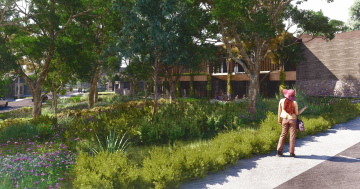
The Federal Golf Club course in Red Hill is one of Canberra’s most picturesque. Photo: Region.
The Federal Golf Club’s $100 million retirement development plans have hit a snag with the number of proposed tree removals facing opposition from the Conservator of Flora and Fauna.
The Environment, Planning and Sustainable Development Directorate has issued the club’s development partner MBark with a request for further information, covering the Conservator’s concerns about biodiversity impacts and tree removals, as well as some from Transport Canberra and City Services.
Until the information is provided, the village development application is effectively on ice.
The request to MBark suggests that changes might have to be made to the design of the proposed development and notes the public interest in the proposal.
“It is recommended to address entity concerns prior to assessment being undertaken/complete as it appears that some design changes may be required to meet the entity advice below,” it says.
“It is also strongly encouraged to respond to representor concerns as part of the further information response as it appears this proposal has a high community interest.”
Mbark proposes to build 125 dwellings, including 77 single-storey houses and 48 apartments across six three-storey buildings, and a health and wellbeing centre for residents on six hectares of the course.
A pond and access road are also planned, as well as a reconfiguring of the course.

An artist’s impression of the proposed retirement village development, totalling 125 dwellings. Image: GDH.
According to the village DA’s Tree Management Plan, a total of 388 trees will need to be removed for the project to proceed, and 313 of these are regulated.
However, the Conservator says it would not support the removal of medium, medium to high and high-quality regulated trees on the site.
It would only approve the removal of 40 trees, including five of poor quality, 34 not covered by the Urban Forest Act 2024, and one pest plant.
Tree Management Plans in three other DAs – for the access road, dam and reconfigured course – list a total of 369 trees for removal, including 178 regulated.
“It is unlikely tree removal will be supported when there is a significant number of medium to high-quality trees being requested for removal,” the letter says.
Mbark will have to provide the total number of trees it wants to clear across the entire 6 ha site to the Tree Removal Unit “as a piecemeal approach does not provide a clear impact of tree loss or the impact it will have on the surrounding suburb or neighbouring properties”.
It will also have to to confirm whether the Gang-gang nest tree known as “Clares” will be retained.
One of the key objections to the proposal is the impact it will have on Gang-gang nesting areas.

The Federal Golf Club retirement village site plan shows the area to be carved out for the proposed development and the access road. Image: GDH.
Mbark is also required to submit a revised Biodiversity Sensitive Urban Design response to address proposal feedback on a range of environmental issues from representations.
These include impacts to wildlife corridors, loss of native habitat, biodiversity buffer zones, light spill and pollution impacts, invasive species, bushfire protection and water run-off.
If the club decides to revise the DA and submits amendments, the assessment clock will restart.
Mbark said in a statement that the feedback on tree impacts was anticipated.
It was a key reason why the club and Mbark sought environmental approvals to proceed with its proposed design from both the ACT Conservator and the Federal Department of Climate Change, Energy, the Environment and Water before lodging its development applications.
“The applications conform with these environmental decisions and the club and Mbark will be responding to the Territory Planning Authority’s further information request in the near future,” the developer said.
Mbark did not respond to questions about how the project could proceed with the Conservator supporting just 40 tree removals, whether a redesign was feasible or if it would consider scaling back the proposal.
EPSDD’s letter can be found on the village DA.
















